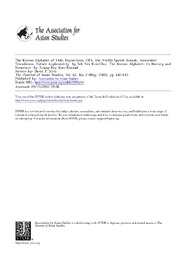
ATTENTION: The works hosted here are being migrated to a new repository that will consolidate resources, improve discoverability, and better show UTA's research impact on the global community. We will update authors as the migration progresses. Please see MavMatrix for more information.
Show simple item record
| dc.contributor.author | Silva, David J. | |
| dc.date.accessioned | 2012-10-30T17:22:14Z | |
| dc.date.available | 2012-10-30T17:22:14Z | |
| dc.date.issued | 2003-05 | |
| dc.identifier.citation | Published in the Journal of Asian Studies 62.2: 640-643 | en_US |
| dc.identifier.uri | http://hdl.handle.net/10106/11207 | |
| dc.description | Review by David J. Solva of The Korean Alphabet of 1446: Expositions, OPA, the Visible Speech Sounds, Annotated
Translation, Future Applicability by Sek Yen Kim-Cho; The Korean Alphabet: Its History and Structure by Young-Key Kim-Renaud. | en_US |
| dc.description.abstract | Perhaps the most noteworthy product of Korean civilization, han'guil is a source
of pride among Koreans: not only does it embody a sense of national uniqueness, but
it is also a valuable tool against illiteracy. While this great cultural achievement has
merited considerable attention in Korea, detailed English-language accounts of
han'guil are scarce. Most prominent among this small body of work is Gari Ledyard's
1966 dissertation, "The Korean Language Reform of 1446," since republished (with
modest revisions) in 1998. Two recent volumes about the Korean script are now
looking to claim space alongside Ledyard's text: The Korean Alphabet of 1446, by Sek
Yen Kim-Cho, and The Korean Alphabet, edited by Young-Key Kim-Renaud.
Although both books seek to further our understanding of what makes han'guil
unique, only Kim-Renaud's edition merits the attention of serious Korean language
scholars; Kim-Cho's contribution, in contrast, falls short what one would expect of a
sound academic inquiry. | en_US |
| dc.language.iso | en_US | en_US |
| dc.publisher | Association for Asian Studies | en_US |
| dc.subject | Korean alphabet | en_US |
| dc.title | Review of The Korean Alphabet of 1446 | en_US |
| dc.type | Article | en_US |
| dc.identifier.externalLink | http://www.uta.edu/ra/real/editprofile.php?onlyview=1&pid=1554 | en_US |
| dc.identifier.externalLinkDescription | Link to Research Profiles | en_US |
Files in this item
- Name:
- ReviewofKoreanAlphabet1446.pdf
- Size:
- 144.2Kb
- Format:
- PDF
- Description:
- PDF
This item appears in the following Collection(s)
Show simple item record


